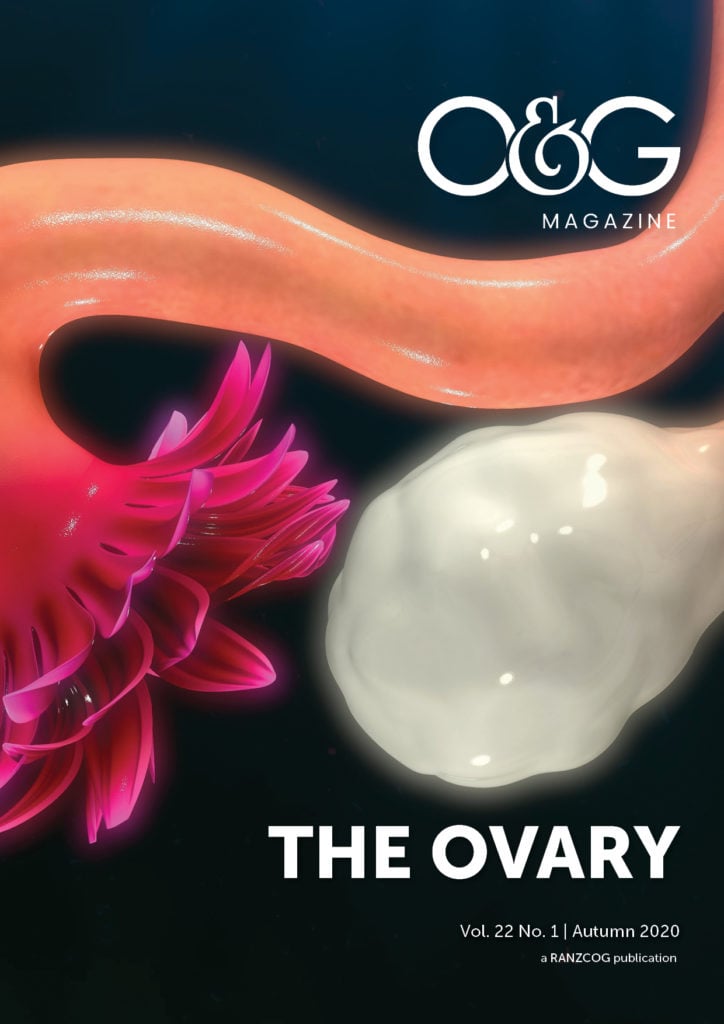Its impact and importance are there in its name: there are many pills in our pharmacopeia, but for everyone, medical or not, the Pill is the oral contraceptive pill, which first became available for Australian women, in the form of Anovlar, in February 1961. The history books tell us that when it was first introduced, it was only available to married women, but I know that isn’t true. I was prescribed Anovlar in 1964, when I was sixteen years old, by a kindly doctor at the Sydney University students’ health clinic, where I had gone seeking treatment for acne. He breezily mentioned its contraceptive side effects. When I told some of my fellow female students about this, they all immediately developed acne.
The Pill is here in an O&G issue about the ovary because it suppresses the regular actions of the ovary. The combined oral contraceptive pill (COCP) contains both an oestrogen and a progestogen. It’s the progestogen that is primarily responsible for preventing pregnancy. Progestogen negative feedback works at the level of the hypothalamus to decrease the pulse frequency of gonadotropin-releasing hormone. This then decreases the secretion of follicle-stimulating hormone (FSH) and luteinising hormone (LH), resulting in inhibition of ovarian follicular development, no LH surge and no follicle release; that is, no ovulation. The progestogen also acts on the endometrium to make it thin and unreceptive to a fertilised ovum, and on cervical mucus to thicken it and prevent sperm penetration. The oestrogen in the Pill has some effect in inhibiting follicular development through its negative feedback on the anterior pituitary, which slows FSH production. The progestogen-only pill (POP) may also suppress ovulation, increase cervical mucus preventing sperm reaching the upper genital tract, and induce endometrial atrophy.
The first generation of COCPs were developed by Gregory Pincus and John Rock in the years following World War II, but the ideas behind the science and the motivation for the research date back to the decades between the two World Wars. The American birth control activist, writer, and trained nurse, Margaret Sanger, had been championing the concept of a birth control pill for many years. In the 1930s, there were initial experiments to extract naturally-occurring steroids from plants, and Dr Carl Djerassi synthesised a progestogen from Mexican yams. Djerassi believed, correctly, that progestogens could inhibit ovulation, but he did not have the means to apply this knowledge to the development of an effective medication.

Photo of Margaret Sanger from George Grantham Bain Collection (Library of Congress).
Rock was an O&G in Boston, educated at Harvard Medical School and very involved in early attempts in fertility research, including IVF and sperm freezing. He was also a committed Catholic who was nevertheless very supportive of Sanger’s work to bring birth control to poor American women. He taught at Harvard in the 1940s and, radically, included birth control in his lectures. Pincus was an eminent American zoologist and physiologist who in 1944 established the Worcester Foundation for Experimental Biology in Shrewsbury, Massachusetts, not far from Boston; he was very interested in steroid hormones and performed successful IVF in rabbits.
Between 1951 and 1953, Sanger brought these two men together, with others, to work on developing a contraceptive pill. She received funds for the work from her friend, wealthy US feminist, suffragette and philanthropist Katharine McCormick.
In 1954, Rock performed a clinical trial on fifty Boston women of the oestrogen/progestogen combination he and Pincus had developed, describing it as a ‘fertility study’. There were no requirements in that era for informed consent or ethics approval, and the trial proceeded without these; its results were promising and further trials were planned. These took place in Puerto Rico, where there were a number of birth control clinics (which up until then were offering only limited barrier methods). Several hundred women took part, again without formal consent, including 200 in a trial in 1956. The contraceptive actions of the combined pill were confirmed, but a number of women reported side effects: nausea, headaches and thrombosis.
The side effects were not considered a problem, however, by the teams developing and administering the drugs, and in 1957 Enovid, consisting of 150 μg mestranol and 9.85 mg norethynodrel, was approved by the US Food and Drug Administration (FDA) for use as a ‘menstrual regulator’; in 1960 the FDA approved Enovid as a contraceptive.
Sanger famously wrote that ‘No woman can call herself free who does not own and control her own body. No woman can call herself free until she can choose consciously whether or not she
can be a mother.’
The Pill was both a part of the changes, and a contributor to the changes, that brought about many improvements in the status of women and the lives of women in the second half of the 20th century, as women strove to attain the freedom glimpsed by Sanger. It was part of a global movement by women (supported by some men) for the right to work, have careers and have equal pay with men; for better healthcare, especially reproductive healthcare; for the right to control one’s own fertility; for better childcare arrangements for working women; and for freedom from sexual harassment and violence. I feel privileged to have lived through this time, seen the changes this movement has brought about, and been a small part of it.
However, the first-generation Pills were far from perfect. By the late 1960s, it was clear that the side effects could be significant for some women. The importance of informing both women wanting contraception and women agreeing to take part in trials, was beginning to be realised, largely due to the vocal demands of the women’s movements in most Western societies. ‘Our Bodies Our Selves’ published in 1971 by the Boston Women’s Health Book Collective became the go-to book for women who wanted to know about, and control, their own fertility; Barbara Seaman’s book ‘The Doctor’s Case Against the Pill’ exposed the lack of informed consent and the concealment of details around the earlier Pill trials.
Moreover, there was strong opposition to the Pill from the Catholic Church. Rock had always championed birth control and he had hoped that his Church would embrace it; he was well aware of the difficulties women – especially poor women in Boston – faced with years of unwanted childbearing. He saw no problem with inhibiting ovulation so that women could choose how many children they wanted to bear; he regarded it as a way of understanding and managing a natural process. Pope Paul VI saw otherwise. In 1968, he stunned many Catholics around the world, including Rock, with the papal encyclical Humanae Vitae, Of Human Life, in which he called artificial birth control ‘intrinsically wrong’ and therefore sinful. Subsequent Popes have confirmed these views. However, birth statistics and research over the 50 years since clearly demonstrate that many Catholics, probably a majority, do not follow this directive.
Work continued in many centres, resulting in the development of newer and safer versions of the original.
In 1972, Gough Whitlam removed the 27.5% ‘luxury tax’ on the Pill in Australia, and put it on the PBS at a total cost to the woman of one dollar (this, obviously, has since increased)! Currently, about 44% of women in Australia who use contraception use the Pill. There has been a subtle shift in recent years to hormonal implants and IUDs, particularly among younger women, but this is still not much more than 10%. First-generation Pills contained as progestogens either norethynodrel, norethisterone or dionogest, together with an oestrogen, mestranol; doses were relatively high and side effects such as nausea and vomiting, and risks including thromboembolism, were a cause for concern.
Second-generation Pills contain as progestogen norgestrel, levonorgestrel, norethisterone or norgestimate, and as oestrogen ethinyloestradiol. These were developed in the 1970s. Doses of both synthetic hormones were very much lower than in the first-generation Pills; risks and side effects were therefore fewer, and much work was done on tailoring hormonal effects to suit particular women’s needs.
Third-generation progestogens are desogestrel, gestodene and cyproterone acetate, together with an oestrogen. Third-generation Pills, which first appeared in the 1990s, have been demonstrated to have a higher risk of thromboembolic events than second generation, although this increased risk is very small. The rather excitable public announcement of this fact in the UK in 1995 led many women to stop the Pill altogether, instead of transferring to known safer options. An estimated 20,000 extra unintended pregnancies and 10,000 abortions were the result. The cost to the National Health Service, the British Pregnancy Advisory Service reported, was enormous; in future, the BPAS said, the level of risk should be more carefully assessed and advice more carefully presented to doctors and women, in the interests of good public health.
Fourth-generation Pills contain drospironone, homogestrel acetate or dienogest as progestogens, and ethinylestradiol, estradiol hemihydrate or estradiol valerate as oestrogens.
We now know a huge amount about oral contraception. If used correctly, it is very effective at preventing conception, while fertility returns quickly on discontinuing it. The risks are well understood and should be considered carefully for every woman it is prescribed for. Cycles can be manipulated and, indeed, dispensed with altogether if the woman wishes. As well as its contraceptive effects it can manage heavy menstrual bleeding, dysmenorrhoea, and symptoms of endometriosis. It can reduce the risks of endometrial, ovarian and bowel cancer, and benign ovarian cysts, and can be useful in managing polycystic ovarian syndrome, premenstrual syndrome and perimenopausal symptoms. And, as my friendly university doctor told me in 1964, it can improve acne! The pill has made an incalculable difference to women’s lives in terms of their ability to manage their own fertility and must be considered one of the greatest advances of the twentieth century.
Further reading
- Boston Women’s Health Book Collective and Judy Norsigian, Our Bodies Ourselves. Boston, 2008.
- Dhont M. History of oral contraception. Eur J Contracept Reprod Health Care. 2010;15 Suppl2:S12-18.
- Sexual Health and Family Planning Australia. Contraception: an Australian clinical practice handbook. 3rd Ed, 2012.
- Sparrow, M. Celebrating more than 50 years of the Pill. O&G Magazine. Vol 18, No 1, Autumn 2016.
- Verma P, Dolin J. Half a century of the oral contraceptive pill. Can Fam Physician. 2012;58(12):e757-60.






Leave a Reply